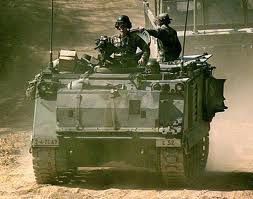October 26, 2015: Strategy Page
Israel has recently made available a lightweight (200 kg/440 pound) version of its Trophy APS (Active Protection System) called Trophy LV. This is intended for MRAPs (heavily armored trucks), IFVs (Infantry Fighting Vehicles) and other heavy vehicles that are lighter than tanks. The regular Trophy weighs about a ton and is one of several APS models on the market but it is also the one with the most impressive combat record.
By 2012 Israel was convinced sufficiently to equip all the Merkava tanks in an armor brigade with the Trophy APS. In 2010 the first battalion of Merkavas was so equipped. Then in 2011 Trophy defeated incoming missiles and rockets in combat for the first time. This included ATGMs (Anti-Tank Guided Missile), possibly a modern Russian system like the Kornet E. This is a laser guided missile with a range of 5,000 meters. The launcher has a thermal sight for use at night or in fog. The missile's warhead can penetrate enough modern tank armor to render the side armor of the Israeli Merkava tank vulnerable. The Kornet E missile weighs 8.2 kg (18 pounds) and the launcher 19 kg (42 pounds). The system was introduced in 1994, and has been sold to Syria (who apparently passed them on to Hezbollah and Hamas). A few weeks before the ATGM intercept Trophy defeated an RPG warhead (an unguided rocket propelled grenade fired from a metal tube balanced on the shoulder). All this came a year after first equipping Merkava tanks with APS. As it was designed to do, Trophy operated automatically and the crew didn't realize the incoming RPG warhead or missile had been stopped until after it was over. That is how APS is supposed to work and Trophy has proved to be the most reliable and effective APS out there.
This first combat use is a big deal because APS has been around for nearly three decades but demand and sales have been slow. The main purpose of APS is to stop ATGMs but on less heavily armored vehicles, stopping RPG type warheads is important as well. This is the main reason for developing Trophy LV.
The Israeli Trophy APS uses better, more reliable, and more expensive technology than the original Russian Drozd (or its successors, like Arena) APS. This includes an electronic jammer that will defeat some types of ATGMs. For about $300,000 per system, Trophy will protect a vehicle from ATGMs as well as RPGs (which are much more common in combat zones). Israel is the first Western nation to have a lot of their tanks shot up by modern ATGMs and apparently fears the situation will only get worse. Trophy protected several Israeli tanks from ATGM and RPG attacks during the 50 Day War with Hamas in mid-2014. The Israeli manufacturer of Trophy also partners with American firms to manufacture Trophy and Trophy LV for the U.S. market.
Israel first encountered ATGMs, on a large scale, in the 1973 Arab-Israeli war. But these were the clumsy, first generation missiles that turned out to be more smoke than fire. More recent ATGM designs have proved more reliable and effective but no nation, except Israel, has yet made a major commitment to APS. That may now change, simply because effective APS like Trophy are available and RPG and ATGM losses are growing.
Most APS consist of a radar to detect incoming missiles and small rockets to rush out and disable the incoming threat. A complete system weighs about a ton. There is also a Trophy Light (weighing half a ton) for lighter, often unarmored, vehicles and now the even lighter Trophy LV for vehicles as small as a hummer.
Russia pioneered the development of these anti-missile systems. The first one, the Drozd, entered active service in 1983, mainly for defense against American ATGMs. These the Russians feared a great deal, as American troops had a lot of them, and the Russians knew these missiles (like TOW) worked. Russia went on to improve their anti-missile systems but was never able to export many of them. This was largely because these systems were expensive (over $100,000 per vehicle), no one trusted Russian hi-tech that much and new tanks, like the American M-1, were seen as a bigger threat than ATGMs.
commenter cet article …



























/http%3A%2F%2Fwww.army-guide.com%2Feng%2Fimages%2FDenel_upgrades_Casspir1366264819.jpg)


